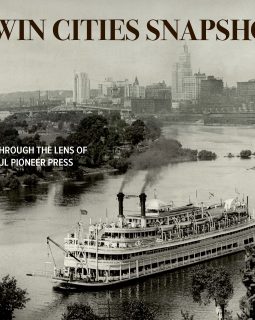Twin Cities Snapshots: History Through the Lens of the St. Paul Pioneer Press

- Year
- 2024
- Creators
- Reviewed by Steve Trimble
- Topics
Twin Cities Snapshots: History Through the Lens of the St. Paul Pioneer Press
St. Paul Pioneer Press, with Nick Woltman and Molly Ballis
Vancouver, WA: Pediment Publishing, 2023
160 pages; hardcover, 250 b&w and color illustrations, $39.95
In April 2024, St. Paul’s Pioneer Press marked its 175th birthday. At its “birth,” the early paper was christened The Minnesota Pioneer. Its name changed to Pioneer Press in 1875 when it merged with the St. Paul Daily Press.[1]
To celebrate this occasion, news staff compiled a pictorial book: Twin Cities Snapshots: History Through the Lens of the St. Paul Pioneer Press, noting:
More family photo album than comprehensive history of the Twin Cities, this . . . is meant to reflect the way our paper has aimed to cover the news since it was founded: with warmth and curiosity. . . .[2]
The book provides a “flash history” of the paper from “Pioneer Days” to the “Digital Age” in seven introductory pages, noting that its first photograph was published in 1895, although the photo is not included nor is it described.
The overall history, which focuses on St. Paul but also covers news in Minneapolis and surrounds, is organized by decades—except chapter one, which begins in 1900 and extends to 1919. This time of rapid change includes the construction of the Cathedral of Saint Paul and our third and current state capitol. Most photos in this section highlight momentous events—a visit by President Theodore Roosevelt, a July 4th celebration on Harriet Island, winter carnival, and parades honoring Civil War veterans of the First Minnesota Volunteer Infantry in 1917 and returning soldiers with the 151st Field Artillery in 1919.
The final chapter also runs longer, with coverage between 2010 and 2023. It begins with news worth celebrating: a new stadium for the Minnesota Twins, state legalization of gay marriage in 2013, and the Minnesota Lynx—our 2015 WNBA champions. The book ends, however, with events that remain fresh and raw in our minds: the devastating COVID-19 pandemic and the upheaval following the murder of George Floyd. Still, the photos selected provide glimpses of hope amid unimaginable tragedy.
A variety of historic still images fill the pages between the first and final chapters: from Mississippi riverboats, street scenes, and bridges to cultural ceremonies, highway construction, snowstorms, and more.
Color photography emerged in the early 1980s. However, some photographers still argue that black and white images can be more impactful. A few examples of this include a euphoric celebration in St. Paul with news of “PEACE!” dominating headlines at the end of World War II. Another touching shot from the ’40s shows three preschoolers sharing juice at Hallie Q. Brown Community Center. The 1952 image of a Chaska man rowing between flooded houses along the swollen Minnesota River is haunting and mystical at the same time. Photographer Dan Spavin’s photo of a girl balancing on a wood plank in front of a Salvation Army store illustrates the mess before the cleanup during a Rice Street widening project in 1957. And photographer Don Church captured a determined Martin Luther King Jr., as he addressed thousands at the University of Minnesota’s St. Paul Campus in 1967.
Over the years, photographers recorded visits by Dwight Eisenhower, Barrack Obama, John McCain, and even Soviet President Mikhail Gorbachev, as well as performances by Elvis, The Beatles, and Prince. In the late 1980s, reporter Jacqui Banaszynski and photographer Jean Pieri followed Bert Henningson and Dick Hanson as they grappled with “AIDS in the Heartland.”
Every-day events—sports, business, or even White Bear Lake residents lined up to vote—all earned a nod in this book. And, of course, Minnesotans’ reactions to the 9-11 attacks and the I-35W bridge collapse are documented.
Not every image from the paper’s photo collections can see the light of day, but there are some subjects that should have been included. For example, there is no mention of the women’s suffrage movement, and it would be nice to see more cultural representation. African American and Native American communities are represented some, but there’s just one image of a single Somali student, and a couple shots representing the Hispanic community, with little to no representation of the larger Hmong and Karen communities, Jewish or Muslim residents, or other groups.
Still, while a few photo history books exist—including Historic Photos of St. Paul (2008)—this addition brings our history up-to-date through 2023 with newsworthy primary sources, many never before seen. These impactful photos invite readers to pause and think about what happened here so long ago—and even not so long ago—to “create collective visual memory.” [3] This was the purpose of the book all along.
Steve Trimble is a St. Paul resident and local historian. He is a member of the Ramsey County Historical Society’s editorial board and a frequent contributor to the magazine.
NOTES
[1] Additional mergers and name changes over the decades are briefly noted in the book.
[2] St. Paul Pioneer Press, Twin Cities Snapshots: History Through the Lens of the St. Paul Pioneer Press (Vancouver, WA: Pediment Publishing, 2003), 7.
[3] St. Paul Pioneer Press, 7.
- Year
- 2024
- Creators
- Reviewed by Steve Trimble
- Topics